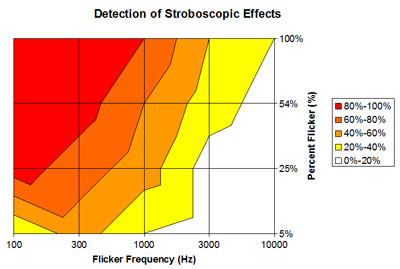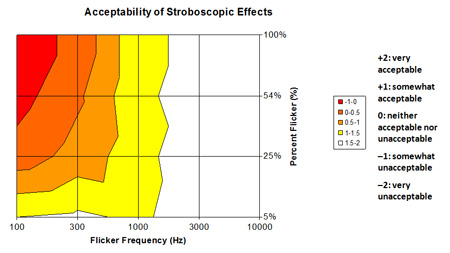Light emitting diodes (LEDs) are ubiquitous in home and personal electronics, and have recently been gaining popularity for use in the automobile industry (car interiors as well as headlamps), outdoor and area lighting, and recently we’ve seen LEDs moving into residential lighting as well. One of the industry’s concerns about bringing LED lighting into the home is; will the LED lighting cause visible flicker, and if so, is that acceptable? I worked on a few flicker-related studies at the Lighting Research Center, led by Senior Research Scientist John Bullough, PhD.
In residences, the ability to modulate the light, or dim the light, is essential to satisfaction from the system (if it is replacing traditional technologies like incandescent which dim very well). Dimming lights, or switching to a lower setting, is also important for lowering energy consumption. Indeed, dimming is one of the strengths of LED replacement technologies. The set-back is that LED replacement lamps will behave differently depending on what type of dimmer they are connected with. If there is an unwanted interaction between the LED replacement lamp and the dimmer, there may be flicker or strobing as a result. Additionally, LEDs that are operated on alternating current (AC) may exhibit flicker. Characteristics that may cause flicker or strobe are: frequency, modulation, duty cycle, or waveform shape.
- Frequency is cycles per second, measured in hertz
- Modulation depth is the range between the on (high light output) and off (low light output)
- In electrical devices, duty cycle is the amount of time the power is on, over the time of the total cycle. If the duty cycle is 30%, the power is on 30% of the time and off 70%.
- Waveform shape can be almost anything in a solid state LED replacement lamp, but some examples of waveform shape are a square wave (square shaped wave formed by turning the LED off for a period of time, and then on for a period of time as in pulse width modulation dimming) or a sinusoidal wave (as commonly seen in an AC cycle).
A set of studies was designed to understand flicker detection, and the role of flicker on comfort and acceptability of a system.
Flicker study 1:
Subjects were shown a variety of lighting conditions in a controlled office-like environment. Conditions included frequency (50, 60, 100, 120 and 300 Hz), modulation depth (100% and 33% flicker), duty cycle (50% and 10%), waveform shape (rectangular and sinusoidal) and CCT (2700 K and 4000 K). Subjects were asked to perform a variety of tasks such as moving their hands, or a white wand, under the LED fixture apparatus or moving their eyes back and forth between two points on the far wall.
Results – Flicker study 1:
The studies showed that flicker is directly visible at 60 Hz and lower, as has been shown by previous research. Flicker visible at 60 Hz and lower was rated as unacceptable. It was seen that at frequencies of 100 Hz or higher (with 50% duty cycles and 100% modulation depth), flicker was not visible and was rated as acceptable. At 300 Hz, subjects were able to perceive flicker stroboscopically, for instance when waving a hand under the LED light fixture apparatus.
Duty cycle and waveform shape were not seen to have an affect on flicker detection, however changes in modulation depth had an affect on perception of stroboscopic flicker in some cases.
Flicker study 2:
Using the same apparatus as the first experiment, subjects were shown a variety of flicker combinations including frequency (100, 300, 1000, 3000 and 10,000 Hz) and modulation depth (100%, 54%, 25% or 5% flicker), and asked to perform a variety of tasks such as moving their hands, or a white wand, under the LED fixture apparatus.
Results – Flicker study 2:
The results can be seen plotted here:


(from Bullough et al. “Detection and acceptability of stroboscopic effects from flicker”)
The graphs here suggest that both frequency and the amount of modulation of the flicker affect perception of indirect flicker (stroboscopic effects), and these variable interact. Those interested in creating systems that have no flicker or acceptable flicker, may benefit from trying out combinations of frequency and modulation based on the results shown here.
For more information see these publications on flicker:
Bullough, J. D., N. P. Skinner and K. Sweater Hickcox. 2012. Visual performance and perceived lighting quality under flickering illumination. Light Sources 2012: Proceedings of the 13th International Symposium on the Science and Technology of Lighting, June 24-29, 2012, Troy, New York, pp. 375–376. Sheffield, UK: Foundation for the Advancement of the Science and Technology of Light Sources.
Bullough, JD PhD, K Sweater Hickcox, TR Klein M and Narendran N PhD. Effects of flicker characteristics from solid-state lighting on detection, acceptability and comfort. Sept 2011, Lighting Research and Technology Journal Vol 43, pg337-348
Bullough, J. D., K. Sweater Hickcox, T. R. Klein, A. Lok and N. Narendran. 2012. Detection and acceptability of stroboscopic effects from flicker. Lighting Research and Technology 44(4): 477-483.
also download more information at the LRC website here
